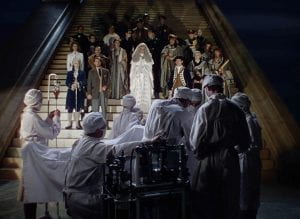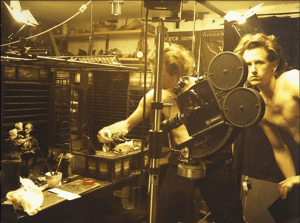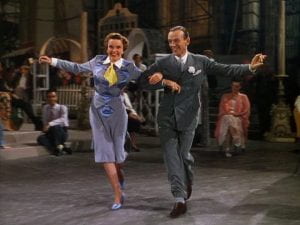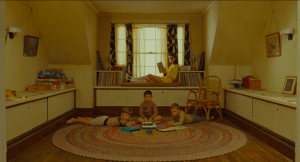Every month, A Place for Film brings you a selection of films from our group of regular bloggers. Even though these films aren’t currently being screened at the IU Cinema, this series reflects the varied programming that can be found at the Cinema and demonstrates the eclectic tastes of the bloggers. Each contributor has picked one film that they saw this month that they couldn’t wait to share with others. Keep reading to find out what discoveries these cinephiles have made, as well as some of the old friends they’ve revisited.
To hear more about this month’s picks, be sure to join us for the live portion of this round-up, which will be presented as a virtual event tomorrow, May 3. Register now!
Aja Essex, contributor | A Matter of Life and Death (1946)
Sometimes as an optimist you still need pieces of art to reaffirm your core belief that, while the world is largely bad, there are still enough elements of pure joy to keep you going on your hopefully long tour through this thing called life. As a cinephile who loves all shades of cinema from the micro to the grandiose, there are movies that will come to your attention and remind you that this medium is a never-ending well you can discover no matter where you are in life and how old you get. A Matter of Life and Death is one such film that reminds me of the simple but deeply affecting pleasure and love that extraordinary craftsmanship brings to me.
Directed by Michael Powell and Emeric Pressburger (often called “The Archers”) — two British wartime and post-war directors known for their ability to bring sweeping scale and striking color to the big screen, like in their best-known films The Red Shoes and Black Narcissus — A Matter of Life and Death stands in their filmography to me as the unfettered love letter to the importance of having something to hold onto. Filmed in sweetly saturated Technicolor and well-balanced black and white and acted superbly by David Niven, Kim Hunter, Roger Livesey, Marius Goring, and many others (including a notable small part by a young Richard Attenborough), I bring A Matter of Life and Death to this semester’s round-up as a celebration of a recent rediscovery from two of the most imaginative filmmakers to put image on film.
Laura Ivins, contributor | Street of Crocodiles (1986)
A man spits into a machine — “the wooden esophagus” — causing rusty razor blades to rotate, pulling twine through a dusty urban landscape. This world, the Street of Crocodiles, perverts our usual categories of matter. Screws behave like scurrying mice; pocket watches are filled with flesh instead of gears; and dandelion seeds flop like insects in the dirt. Even the tailor’s assistants defy expectation by moving with intention at first but then mechanistically a few minutes later.
The Quays’ film is a fitting adaptation of its source material, a short story by Polish author Bruno Schulz, but not because it slavishly follows Schulz’ narrative. Instead, the Quays capture the otherworldly feeling that runs through Schulz’ work. In “Street of Crocodiles,” Schulz’s young narrator writes of the eponymous street, “Gestures hang in the air, movements are prematurely exhausted and cannot overcome a certain point of inertia.”
But Schulz is not the only influence on the film. We also see nods to surrealism in the mannequin suspended from the ceiling (in the Surrealist Centrale in 1930s Paris, a mannequin with no head or arms hung over the proceedings) and the striped box that harkens back to Un Chien Andalou (Luis Buñuel and Salvador Dalí, 1929). (In fact, two years earlier the Quays made a short film dedicated to Czech surrealist Jan Švankmajer: The Cabinet of Jan Švankmajer.)
It’s hard to articulate what makes this film so effective and enduring. There’s something about the combination of Leszek Jankowski’s haunting score, the dance of the camera through this grimy world, and the poignancy of objects seeming to struggle against their own existence. It’s a film I can return to again and again and always feel its weight.
Note: no trailer could be found for this short film, but you can watch this clip instead.
Noni Ford, contributor | Moonrise Kingdom (2012)
Welcome to the island of New Penzance, the setting of a coming-of-age romantic comedy and Wes Anderson’s seventh film. In the summer of 1965, the once peaceful town is rocked by the young love affair of a Khaki Scout named Sam Shakusky and a bookish girl from a dysfunctional family named Suzy Bishop. The couple may be only twelve, but their love runs deep and when they decide to escape together into the wilderness they trigger a domino effect as the adults of New Penzance fall into disarray trying to find them. While Suzy’s parents and the authority figures of the island, chiefly Scout Master Randy Ward (played by Edward Norton) and Police Captain Duffy Sharp (played by Bruce Willis), are prominently featured, it is still the children that often take center stage in this story.
The children in Anderson’s film are precocious but not obnoxiously so; they have their own quirks and awkwardness about them, however they all seem to have a great amount of conviction and integrity. The latter are traits that many of the adult characters lack at times. Yes, this may just be a wild summer, and Sam and Suzy may be unprepared for life on the run but moment to moment we feel and see the love they share and its transformative power to even convert some of their peers into allies later on in the film. The whole story is told with classic Anderson hallmarks: an Alexandre Desplat score, symmetric cinematography, intricate set designs, and plenty of witty jokes. There are stakes that the characters must face and lighter, comedic moments throughout. The film revels in the daydreams and promises of first love, capturing the longing and tenderness in equal measure. I’m so excited to talk about this film and hopefully introduce it to new audiences ahead of its 10-year anniversary on May 25th.
Jesse Pasternack, contributor | Stop Making Sense (1984)
I often take notes on the movies about which I write. Sometimes they’re brief reminders of things I should remember. Other times they’re lengthy ruminations on something that catches my interest. But, whether it’s one word or 100, I always make sure to scribble down at least a few notes on a movie if I’m going to write a piece on it.
That did not happen during my latest viewing of Stop Making Sense. As always, I got so caught up in the great songs by Talking Heads and the equally great filmmaking by director Jonathan Demme and his team of collaborators that I was unable to approach it with anything approaching critical thought. Instead it enveloped me, as the greatest works of art always do.
That highly immersive quality to Stop Making Sense is key to its success as what Demme once called a “performance film.” In an interview included on the DVD release of his 1987 performance film Swimming to Cambodia, Demme defined a performance film as a type of cinematic translation of a live performance that “gives someone who can’t go to the theater the best seat in the house.” Everything about this movie — its enveloping cinematography by Jordan Cronenweth, the skillful narrative rhythms created by the editing of Lisa Day, and even the lighting design by lead singer/major creative force David Byrne and Beverly Emmons — makes you feel like you’re at the Pantages Theater, experiencing the performance by Talking Heads in real time. That achievement is even more impressive when you learn that this film was actually edited together from three different performances given by Talking Heads to promote their album Speaking in Tongues.
Even though it’s only 88 minutes long, there is much to enjoy and analyze in Stop Making Sense. There are the major moments, such as Byrne dancing in his justly famous big suit while performing “Girlfriend Is Better” or bassist Tiny Weymouth scampering around like a crab during “Genius of Love.” But, whenever I revisit it, I find myself gravitating toward the smaller moments. Whether it is the way that the drummer Chris Frantz’s eyes light up when he vibes with the band, or percussionist Steve Scales dancing in time to the music before he turns to make a funny face at the camera, this film is full of little details that are endlessly fascinating. They all add up to make a mosaic which is a beautiful tribute to the incomparable, life-affirming joy of making music.
Stop Making Sense is the type of film I could write about for hours, filling paragraph after paragraph with my appreciation of and delight for its artistry and passion. I’ll close by noting that I had the good fortune to meet Jonathan Demme a few times. We never discussed this film — one of my few regrets — but he was as warm and nice as his reputation had suggested. He was essentially what Stop Making Sense would be like if it was a person, and his example is a reminder that we should all strive to treat people with the warmth and kindness we feel when we watch our favorite films.
Michaela Owens, Editor | Easter Parade (1948)
When the dance partner he is in love with, Nadine (a wonderfully bitchy Ann Miller), walks out on him, entertainer Don Hewes (Fred Astaire) decides to get his revenge by randomly picking a new partner, Hannah (Judy Garland), and proving he can make anyone a star. As they spend more time together, Hannah finds herself falling for an oblivious Don, while Don’s friend and the man Nadine wants, Johnny (a truly adorable Peter Lawford), becomes besotted with Hannah.
In my opinion, Easter Parade is one of the most brilliant (and underrated) musicals put on celluloid. Filmed in gorgeous Technicolor and directed by my beloved Charles Walters, it is filled to the brim with musical excellence, from Astaire’s showstopping “Steppin’ Out with My Baby” to his and Garland’s iconic “A Couple of Swells” to Miller’s stunning “Shakin’ the Blues Away.” Easter Parade should also be cherished because it is the only collaboration between Judy Garland and Fred Astaire. As two of the best entertainers this world has ever seen, it gives me goosebumps to see them perform together.
This delectable, unforgettable Pygmalion tale set to Irving Berlin tunes is not a film to be missed. It is a captivating example of the enchantment that only classic Hollywood could create, and it will forever be a film that holds a special place in my heart. Ever since I laid eyes on it over a decade ago, it has felt like a part of me and I cannot wait to talk about it with my fellow bloggers.




